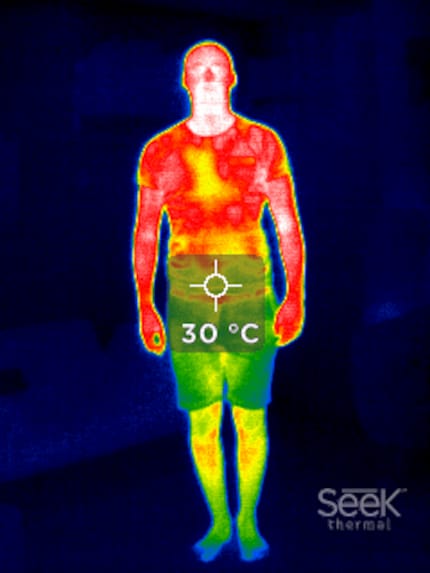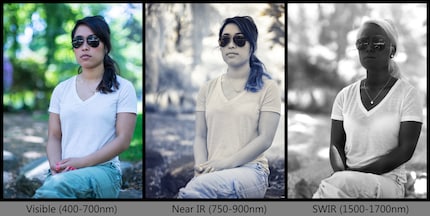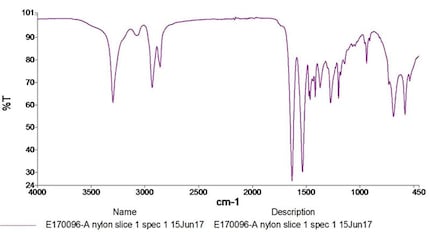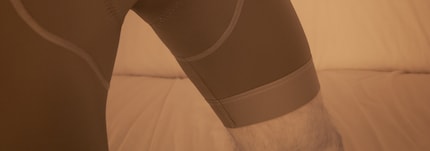
Guide
Motorola Edge 60 Fusion vs. Motorola Edge 60 Pro – is the Pro upgrade worth it?
by Florian Bodoky

Why can't I see through clothes with my infrared camera? A short physics lesson about nanometres, transmittance and indium gallium arsenide.
I can't see through clothes with my infrared camera. I recently tried it out. The reason for this was the OnePlus 8 Pro smartphone, with which this is supposedly possible under certain conditions.
This fun article does not clarify the question of whether it is generally possible to "see" through material with infrared - and if so, why. Reading through your comments, I realised that I only have half-knowledge of physics myself.
Let's take a closer look at this.
In physical terms, colours are light waves and these are a special case of electromagnetic waves. In other words, electromagnetic radiation with a specific wavelength.
We see a different colour depending on the wavelength. The colour spectrum by wavelength looks like this:
The shortest wavelength that we can still see appears purple. Even shorter wavelengths are therefore referred to as ultraviolet. However, they are not violet, but invisible. At the other end of the spectrum, the longest visible waves are red. Even longer waves are therefore called infrared.
The wavelengths for visible light are in the three-digit nanometre range (380 to 780 nm). A nanometre is one millionth of a millimetre or one thousandth of a micrometre. Electromagnetic waves can be described not only in terms of length, but also in terms of frequency. A shorter wave has a higher frequency.
Infrared covers the range from 780 nm to 1 millimetre, i.e. 1,000,000 nm. The wave spectrum is therefore much broader than that of visible light. It is therefore common to divide infrared waves into different categories. There are various subdivisions, here is the one that is commonly used in English-speaking countries.
Just as there are different infrared ranges, there are also different infrared cameras.
An "ordinary infrared camera", which is used to take these typical infrared images with white plant leaves, can only image near infrared. More precisely, only a part of the near infrared, namely waves up to 1100 nm.
The reason for this is the photosensor. It does not react to longer waves. This in turn has to do with the semiconductor material used. These infrared cameras use the same sensors as ordinary cameras, and silicon is always used.
Infrared cameras are also sometimes referred to as infrared cameras, but they map a completely different wavelength range. A normal camera cannot be converted into a thermal imaging camera. This is because thermal imaging cameras image much longer infrared waves, often waves that are no longer infrared at all. The sensor must consist of a semiconductor that responds to these wavelengths, for example vanadium oxide or amorphous silicon.
This thermal imaging camera "sees" wavelengths from 8 to 14 μm. It has a resolution of 220 x 160 pixels. Thermal imaging cameras generally have much lower resolutions than normal cameras. To a certain extent, such a device can see underneath clothing, but only in the sense that certain parts of the body are closer to the clothing and therefore appear warmer or are actually warmer.
An exact depiction of the anatomy is not possible. In some cases, the image from an ordinary photo sensor is taken at the same time and mixed with the thermal image to better show the contours. But these contours do not reveal anything hidden.
The Cat S60 and S61 smartphones also have a thermal imaging camera. However, its extremely low resolution of 80×60 pixels makes it impossible in principle to record overly intimate details.
Many materials allow certain wavelengths to pass through, others do not. For example, glass is transparent to visible light, but blocks most ultraviolet light. You can tell by the fact that you don't get sunburnt behind a pane of glass.
Are there also materials that are opaque to visible light but transparent to infrared light? Logical: The infrared pass filter for the lens.
The exciting question now is: Are there any materials that act like an IR pass filter, even in clothing?
A fabric that an IR camera can see through would have to have the following properties:
Polyamide 6.6, better known as nylon, has the property of being transparent to certain infrared waves. This diagram shows at which wavelengths this is the case.
Unfortunately, this spectrum - like all the others I have found - does not show exactly the range that is relevant for IR photography. The unit of measurement used here is cm-1, which means: 1 divided by the respective number gives the wavelength in cm. The spectrum starts at 1/4000 cm-1 = 0.00025 cm, which is 2500 nm. This means that the shortest wavelength analysed is already too long for an infrared camera that images the 780-1100 nm range.
My cycling shorts are made of 80 per cent polyamide and 20 per cent elastane - a mixture that is also widely used in swimwear. This fabric is not transparent to the infrared camera. Even if it is not 100 per cent polyamide, it is reasonable to assume that polyamides are not transparent in the near infrared range.
The visible colour says nothing about what a surface looks like in the infrared image. For example, green plant leaves appear white, but an artificial plant does not. The decisive factor is the material. Real plants contain chlorophyll, which reflects infrared particularly strongly.
A material can be transparent for certain wavelengths and not for others; it is therefore theoretically possible that clothes are only transparent in the infrared image. In practice, however, I have not yet found any clothing material where this is actually the case.
The situation is different with thermal imaging cameras: Thermal radiation naturally penetrates thin fabric without any problems. But with a resolution of 80 x 60 pixels, as with the Cat S61, a thermal imaging camera cannot possibly be misused for voyeurism.
Short-wave infrared can barely see through clothes, long-wave infrared can only be imaged with special devices and poor resolution. I therefore come to the same conclusion as in the first article on this topic: it is not impossible, but very unlikely, that infrared cameras will be used to expose intimacies.
My interest in IT and writing landed me in tech journalism early on (2000). I want to know how we can use technology without being used. Outside of the office, I’m a keen musician who makes up for lacking talent with excessive enthusiasm.
Practical solutions for everyday problems with technology, household hacks and much more.
Show all
| Designation | Wavelengths |
|---|---|
| Near Infrared (NIR) | 780-1400 nm |
| Short-Wavelength Infrared (SWIR) | 1400-3000 nm |
| Mid-Wavelength Infrared (MWIR) | 3-8 µm |
| Long-Wavelength Infrared (LWIR) | 8-15 µm |
| Far Infrared (FIR) | 15 µm-1000 µm |


In this comparison, the photo on the far left was taken with a normal camera, the one in the centre with a "normal infrared camera", i.e. a normal camera without an IR cut filter. The photo on the far right shows longer infrared waves that can only be captured with a special SWIR camera. Typical for SWIR photos is that all people have black skin. SWIR cameras have a sensor made of indium gallium arsenide. They also only have a very low resolution. For such a portrait, a large number of photos have to be taken and stitched together like a panorama.
Most of the colours we see are not direct light sources, but reflected light. The colour of a surface is created by the fact that only certain wavelengths are reflected. An orange colour reflects wavelengths between 630 and 590 nm and absorbs the rest. A white paper reflects all visible wavelengths, because white is the sum of all light colours. Conversely, black reflects nothing, but absorbs everything.
However, there are also materials that neither absorb nor reflect light. They are transparent.




ASUS ROG Swift OLED PG27UCDM
3840 x 2160 Pixels, 26.50"